Related Research Articles

Bioinformatics is an interdisciplinary field of science that develops methods and software tools for understanding biological data, especially when the data sets are large and complex. Bioinformatics uses biology, chemistry, physics, computer science, computer programming, information engineering, mathematics and statistics to analyze and interpret biological data. The subsequent process of analyzing and interpreting data is often referred to as computational biology, though the distinction between the two terms is often disputed.

Biodiversity is the variety and variability of life on Earth. It can be measured on various levels. There is for example genetic variability, species diversity, ecosystem diversity and phylogenetic diversity. Diversity is not distributed evenly on Earth. It is greater in the tropics as a result of the warm climate and high primary productivity in the region near the equator. Tropical forest ecosystems cover less than one-fifth of Earth's terrestrial area and contain about 50% of the world's species. There are latitudinal gradients in species diversity for both marine and terrestrial taxa.

Biological control or biocontrol is a method of controlling pests, whether pest animals such as insects and mites, weeds, or pathogens affecting animals or plants by using other organisms. It relies on predation, parasitism, herbivory, or other natural mechanisms, but typically also involves an active human management role. It can be an important component of integrated pest management (IPM) programs.

Human ecology is an interdisciplinary and transdisciplinary study of the relationship between humans and their natural, social, and built environments. The philosophy and study of human ecology has a diffuse history with advancements in ecology, geography, sociology, psychology, anthropology, zoology, epidemiology, public health, and home economics, among others.
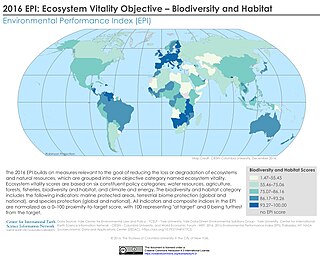
Conservation biology is the study of the conservation of nature and of Earth's biodiversity with the aim of protecting species, their habitats, and ecosystems from excessive rates of extinction and the erosion of biotic interactions. It is an interdisciplinary subject drawing on natural and social sciences, and the practice of natural resource management.

Seagrasses are the only flowering plants which grow in marine environments. There are about 60 species of fully marine seagrasses which belong to four families, all in the order Alismatales. Seagrasses evolved from terrestrial plants which recolonised the ocean 70 to 100 million years ago.

A BioBlitz, also written without capitals as bioblitz, is an intense period of biological surveying in an attempt to record all the living species within a designated area. Groups of scientists, naturalists, and volunteers conduct an intensive field study over a continuous time period. There is a public component to many BioBlitzes, with the goal of getting the public interested in biodiversity. To encourage more public participation, these BioBlitzes are often held in urban parks or nature reserves close to cities. Research into the best practices for a successful BioBlitz has found that collaboration with local natural history museums can improve public participation. As well, BioBlitzes have been shown to be a successful tool in teaching post-secondary students about biodiversity.
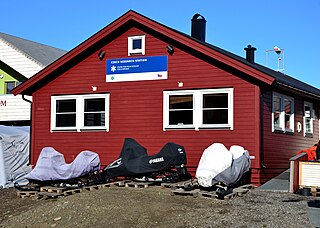
Research stations are facilities where scientific investigation, collection, analysis and experimentation occurs. A research station is a facility that is built for the purpose of conducting scientific research. There are also many types of research stations including: biological field stations, space stations etc. Research station sites might include remote areas of the world, oceans, as well as outer space, such as the International Space Station. Biological research stations developed during a time of European colonization and imperialism where naturalists were employed to conduct observations on fauna and flora. Today, the discipline is represented by a number of organizations which span across multiple continents. Some examples include: the Organization of Biological Field Stations and the Organization for Tropical Studies.

A bioindicator is any species or group of species whose function, population, or status can reveal the qualitative status of the environment. The most common indicator species are animals. For example, copepods and other small water crustaceans that are present in many water bodies can be monitored for changes that may indicate a problem within their ecosystem. Bioindicators can tell us about the cumulative effects of different pollutants in the ecosystem and about how long a problem may have been present, which physical and chemical testing cannot.

Environmental education (EE) refers to organized efforts to teach how natural environments function, and particularly, how human beings can manage behavior and ecosystems to live sustainably. It is a multi-disciplinary field integrating disciplines such as biology, chemistry, physics, ecology, earth science, atmospheric science, mathematics, and geography.
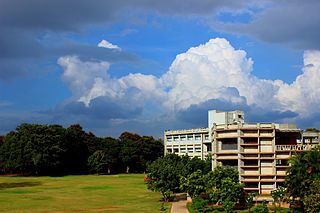
National Centre for Biological Sciences (NCBS) in Bangalore, Karnataka, is a research centre specialising in biological research. It is a part of the Tata Institute of Fundamental Research (TIFR) under the Department of Atomic Energy of the Government of India. The mandate of NCBS is basic and interdisciplinary research in the frontier areas of biology. The research interests of the faculty are in four broad areas ranging from the study of single molecules to systems biology. Obaid Siddiqi FRS was an Indian National Research Professor and the Founder-Director of NCBS. He made seminal contributions to the field of behavioural neurogenetics using the genetics and neurobiology of Drosophila.
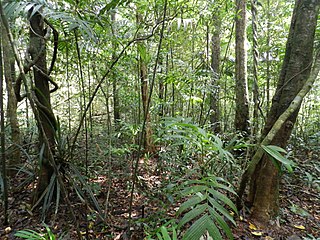
Building blocks for tropical rainforest conservation include ecotourism and rehabilitation. Reforestation and restoration are common practices in certain areas to try to increase tropical rainforest density. By communicating with the local people living in, and around, the rainforest, conservationists can learn more about what might allow them to best focus their efforts. Rainforests are globally important to sustainability and preservation of biodiversity. Although they may vary in location and inhabited species of plants and animals, they remain important worldwide for their abundance of natural resources and for the ecosystem services. It is important to take into consideration the differing species and the biodiversity that exists across different rainforest types in order to accurately implement methods of conservation.
The Organization of Biological Field Stations (OBFS) is a nonprofit multinational organization representing the field stations and research centers across Canada, United States, and Central America. While it has no administrative or management control over its member stations, it helps to improve their effectiveness in research, education, and outreach through various initiatives. This includes promoting the establishment of research networks, working with public agencies to enhance funding sources, and building interactions between scientists and policy makers.

Soundscape ecology is the study of the acoustic relationships between living organisms, human and other, and their environment, whether the organisms are marine or terrestrial. First appearing in the Handbook for Acoustic Ecology edited by Barry Truax, in 1978, the term has occasionally been used, sometimes interchangeably, with the term acoustic ecology. Soundscape ecologists also study the relationships between the three basic sources of sound that comprise the soundscape: those generated by organisms are referred to as the biophony; those from non-biological natural categories are classified as the geophony, and those produced by humans, the anthropophony.
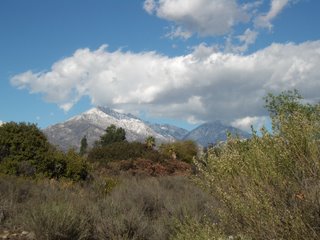
The 85 acre Robert J. Bernard Biological Field Station (BFS) is located on the north side of Foothill Boulevard between College Avenue and Mills Avenue in Claremont, California. The BFS provides facilities and ecological communities for high-quality teaching and research in biological, environmental, and other sciences to the students, faculty, and staff of the Claremont Colleges. It may also be used by members of other academic institutions and by public groups for educational purposes. The BFS is a member of the Organization of Biological Field Stations (OBFS). It was named after Claremont Colleges president Robert J. Bernard.

A biological specimen is a biological laboratory specimen held by a biorepository for research. Such a specimen would be taken by sampling so as to be representative of any other specimen taken from the source of the specimen. When biological specimens are stored, ideally they remain equivalent to freshly-collected specimens for the purposes of research.

William J. Ripple is a professor of ecology at Oregon State University in the Department of Forest Ecosystems and Society. He is best known for his research on terrestrial trophic cascades, particularly the role of the gray wolf in North America as an apex predator and a keystone species that shapes food webs and landscape structures via “top-down” pressures.

William F. Laurance, also known as Bill Laurance, is Distinguished Research Professor at James Cook University, Australia and has been elected as a Fellow of the Australian Academy of Science. He has received an Australian Laureate Fellowship from the Australian Research Council. He held the Prince Bernhard Chair for International Nature Conservation at Utrecht University, Netherlands from 2010 to 2014.
Jennifer Lee is an Antarctic researcher, best known for her work on invasion biology. She is the Environment Officer in the Government of South Georgia and the South Sandwich Islands.
The anthropause was a global reduction in modern human activity, especially travel, that occurred during the COVID-19 pandemic, particularly in March and April 2020. It was coined by a team of researchers in June 2020 in an article discussing the positive impact of the COVID-19 lockdown on wildlife and environment. The scientific journal that published the commentary, Nature Ecology and Evolution, selected the topic for the cover of its September issue, with the headline "Welcome to the anthropause". Oxford Languages highlighted the word "anthropause" in its 2020 Words of an Unprecedented Year report.
References
- ↑ "OBFS - What is a Field Station?". www.obfs.org.
- ↑ Wyman, Richard L.; Baine, Mark; Wallensky, Eugene (1 July 2009). "The Activities and Importance of International Field Stations". BioScience. 59 (7): 587. doi:10.1525/bio.2009.59.7.9. S2CID 86230924.
- ↑ Tydecks, Laura; Bremerich, Vanessa; Jentschke, Ilona; Likens, Gene; Tockner, Klement (13 January 2016). "Biological Field Stations: A Global Infrastructure for Research, Education, and Public Engagement". BioScience. 66 (2): 164–171. doi: 10.1093/biosci/biv174 .
- ↑ Eppley, Timothy M.; Reuter, Kim E.; Sefczek, Timothy M.; Tinsman, Jen; Santini, Luca; Hoeks, Selwyn; Andriantsaralaza, Seheno; Shanee, Sam; Fiore, Anthony Di; Setchell, Joanna M.; Strier, Karen B.; Abanyam, Peter A.; Mutalib, Aini Hasanah Abd; Abwe, Ekwoge; Ahmed, Tanvir (2024-03-04). "Tropical field stations yield high conservation return on investment". Conservation Letters. doi: 10.1111/conl.13007 . hdl: 11573/1706649 . ISSN 1755-263X.